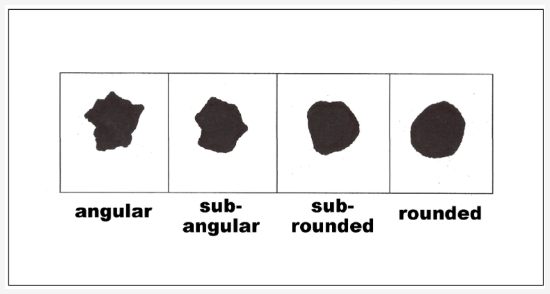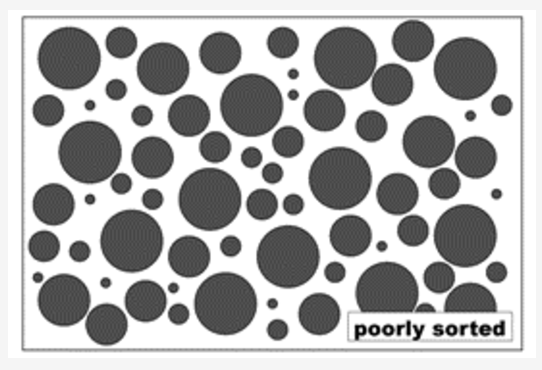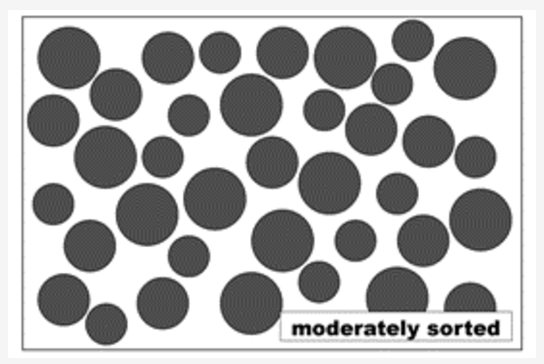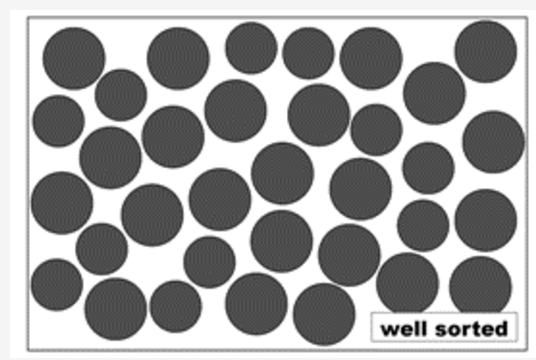3.7: Sedimentary Rocks
- Page ID
- 2502
\( \newcommand{\vecs}[1]{\overset { \scriptstyle \rightharpoonup} {\mathbf{#1}} } \)
\( \newcommand{\vecd}[1]{\overset{-\!-\!\rightharpoonup}{\vphantom{a}\smash {#1}}} \)
\( \newcommand{\id}{\mathrm{id}}\) \( \newcommand{\Span}{\mathrm{span}}\)
( \newcommand{\kernel}{\mathrm{null}\,}\) \( \newcommand{\range}{\mathrm{range}\,}\)
\( \newcommand{\RealPart}{\mathrm{Re}}\) \( \newcommand{\ImaginaryPart}{\mathrm{Im}}\)
\( \newcommand{\Argument}{\mathrm{Arg}}\) \( \newcommand{\norm}[1]{\| #1 \|}\)
\( \newcommand{\inner}[2]{\langle #1, #2 \rangle}\)
\( \newcommand{\Span}{\mathrm{span}}\)
\( \newcommand{\id}{\mathrm{id}}\)
\( \newcommand{\Span}{\mathrm{span}}\)
\( \newcommand{\kernel}{\mathrm{null}\,}\)
\( \newcommand{\range}{\mathrm{range}\,}\)
\( \newcommand{\RealPart}{\mathrm{Re}}\)
\( \newcommand{\ImaginaryPart}{\mathrm{Im}}\)
\( \newcommand{\Argument}{\mathrm{Arg}}\)
\( \newcommand{\norm}[1]{\| #1 \|}\)
\( \newcommand{\inner}[2]{\langle #1, #2 \rangle}\)
\( \newcommand{\Span}{\mathrm{span}}\) \( \newcommand{\AA}{\unicode[.8,0]{x212B}}\)
\( \newcommand{\vectorA}[1]{\vec{#1}} % arrow\)
\( \newcommand{\vectorAt}[1]{\vec{\text{#1}}} % arrow\)
\( \newcommand{\vectorB}[1]{\overset { \scriptstyle \rightharpoonup} {\mathbf{#1}} } \)
\( \newcommand{\vectorC}[1]{\textbf{#1}} \)
\( \newcommand{\vectorD}[1]{\overrightarrow{#1}} \)
\( \newcommand{\vectorDt}[1]{\overrightarrow{\text{#1}}} \)
\( \newcommand{\vectE}[1]{\overset{-\!-\!\rightharpoonup}{\vphantom{a}\smash{\mathbf {#1}}}} \)
\( \newcommand{\vecs}[1]{\overset { \scriptstyle \rightharpoonup} {\mathbf{#1}} } \)
\( \newcommand{\vecd}[1]{\overset{-\!-\!\rightharpoonup}{\vphantom{a}\smash {#1}}} \)
\(\newcommand{\avec}{\mathbf a}\) \(\newcommand{\bvec}{\mathbf b}\) \(\newcommand{\cvec}{\mathbf c}\) \(\newcommand{\dvec}{\mathbf d}\) \(\newcommand{\dtil}{\widetilde{\mathbf d}}\) \(\newcommand{\evec}{\mathbf e}\) \(\newcommand{\fvec}{\mathbf f}\) \(\newcommand{\nvec}{\mathbf n}\) \(\newcommand{\pvec}{\mathbf p}\) \(\newcommand{\qvec}{\mathbf q}\) \(\newcommand{\svec}{\mathbf s}\) \(\newcommand{\tvec}{\mathbf t}\) \(\newcommand{\uvec}{\mathbf u}\) \(\newcommand{\vvec}{\mathbf v}\) \(\newcommand{\wvec}{\mathbf w}\) \(\newcommand{\xvec}{\mathbf x}\) \(\newcommand{\yvec}{\mathbf y}\) \(\newcommand{\zvec}{\mathbf z}\) \(\newcommand{\rvec}{\mathbf r}\) \(\newcommand{\mvec}{\mathbf m}\) \(\newcommand{\zerovec}{\mathbf 0}\) \(\newcommand{\onevec}{\mathbf 1}\) \(\newcommand{\real}{\mathbb R}\) \(\newcommand{\twovec}[2]{\left[\begin{array}{r}#1 \\ #2 \end{array}\right]}\) \(\newcommand{\ctwovec}[2]{\left[\begin{array}{c}#1 \\ #2 \end{array}\right]}\) \(\newcommand{\threevec}[3]{\left[\begin{array}{r}#1 \\ #2 \\ #3 \end{array}\right]}\) \(\newcommand{\cthreevec}[3]{\left[\begin{array}{c}#1 \\ #2 \\ #3 \end{array}\right]}\) \(\newcommand{\fourvec}[4]{\left[\begin{array}{r}#1 \\ #2 \\ #3 \\ #4 \end{array}\right]}\) \(\newcommand{\cfourvec}[4]{\left[\begin{array}{c}#1 \\ #2 \\ #3 \\ #4 \end{array}\right]}\) \(\newcommand{\fivevec}[5]{\left[\begin{array}{r}#1 \\ #2 \\ #3 \\ #4 \\ #5 \\ \end{array}\right]}\) \(\newcommand{\cfivevec}[5]{\left[\begin{array}{c}#1 \\ #2 \\ #3 \\ #4 \\ #5 \\ \end{array}\right]}\) \(\newcommand{\mattwo}[4]{\left[\begin{array}{rr}#1 \amp #2 \\ #3 \amp #4 \\ \end{array}\right]}\) \(\newcommand{\laspan}[1]{\text{Span}\{#1\}}\) \(\newcommand{\bcal}{\cal B}\) \(\newcommand{\ccal}{\cal C}\) \(\newcommand{\scal}{\cal S}\) \(\newcommand{\wcal}{\cal W}\) \(\newcommand{\ecal}{\cal E}\) \(\newcommand{\coords}[2]{\left\{#1\right\}_{#2}}\) \(\newcommand{\gray}[1]{\color{gray}{#1}}\) \(\newcommand{\lgray}[1]{\color{lightgray}{#1}}\) \(\newcommand{\rank}{\operatorname{rank}}\) \(\newcommand{\row}{\text{Row}}\) \(\newcommand{\col}{\text{Col}}\) \(\renewcommand{\row}{\text{Row}}\) \(\newcommand{\nul}{\text{Nul}}\) \(\newcommand{\var}{\text{Var}}\) \(\newcommand{\corr}{\text{corr}}\) \(\newcommand{\len}[1]{\left|#1\right|}\) \(\newcommand{\bbar}{\overline{\bvec}}\) \(\newcommand{\bhat}{\widehat{\bvec}}\) \(\newcommand{\bperp}{\bvec^\perp}\) \(\newcommand{\xhat}{\widehat{\xvec}}\) \(\newcommand{\vhat}{\widehat{\vvec}}\) \(\newcommand{\uhat}{\widehat{\uvec}}\) \(\newcommand{\what}{\widehat{\wvec}}\) \(\newcommand{\Sighat}{\widehat{\Sigma}}\) \(\newcommand{\lt}{<}\) \(\newcommand{\gt}{>}\) \(\newcommand{\amp}{&}\) \(\definecolor{fillinmathshade}{gray}{0.9}\)INTRODUCTION
This basics page focuses on sedimentary rocks, which are sediments that were turned into solid rock by geologic processes. Sedimentary rocks contain information about what was occurring on earth’s surface at the place and time the sediments were deposited. In some cases sedimentary rocks contain fossils, which provide information about what was living at a certain place and time on earth.
There are two main groups of sedimentary rocks: chemical and clastic. Clastic is sometimes called detrital. Each type of sedimentary rock is formed when sediments lithify (turn into rock). Chemical sediments are sediments that precipitate from solution, for example salt crystals that grow at the bottom of an evaporating body of water. Clastic sediments are solid pieces of weathered and eroded rocks or minerals, for example sand on a beach.
This page provides the background needed to understand the terms used in the sedimentary rock classification table at the end of this page.
LITHIFICATION—SEDIMENTS TO SEDIMENTARY ROCKS
Sedimentary rocks are rocks made of lithified sediment. Sediments are grains of rocks, minerals, or mineraloids deposited on the surface of the earth. Reflect on the rock cycle for an indication of the relationships between the rocks that erode to become sediments and sedimentary rocks. For sediment to become sedimentary rock, it usually undergoes burial, compaction, and cementation.
Clastic sedimentary rocks are the result of weathering and erosion of source rocks, which turns them into pieces—clasts—of rocks and minerals. Once they become pieces, these clasts are free to move away from their source rock and they usually do. They are most often transported by water and deposited as layers of sediment.
The burial stage of lithification involves the deposition of more sediment layers top of those that had been deposited earlier. In a sedimentary basin where sediment is being deposited, it is common for subsidence (lowering) of the basin to be taking place, either because the crust and lithosphere beneath it are subsiding into the mantle to some extent, or because the surrounding uplands are undergoing uplift relative to the basin, or both. This allows thousands of feet of burial, in some cases tens of thousands of feet of burial, to occur.
As sediments are buried, the weight of overlying material exerts pressure, causing compaction of the sediments. The pressure, known as lithostatic pressure, “squeezes” the sediments from all sides into a smaller volume. Lithostatic pressure packs the sediment grains closer together and reduces the porosity – space between the sediment grains.
Some chemical sedimentary rocks are rock as soon as the sediments have been deposited by crystallization of minerals from substances dissolved in water, at the earth’s surface. Examples include rock salt and other evaporite deposits. These sediments of salt crystals and other minerals form sedimentary rock without having to undergo burial and compaction.
During burial and compaction, sediments will undergo some amount of cementation. Cementation refers to the growth of new minerals between the sediment grains. These new minerals bind the sediment grains together. One form of cementation is growth of quartz rims on the surfaces of pre-existing quartz grains in the sediment. This new mineral growth is a result of water in the pore spaces that dissolves and precipiates quartz. A second common cementing mineral is hematite, a red or rust-colored iron oxide mineral, which precipitates onto the sediment grains from a combination of dissolved iron and oxygen from water in the pore spaces. A third common cementing mineral is calcite, which also precipitates from ions dissolved in the water in the pore spaces during lithification. Although there are other cementing minerals, quartz, hematite, and calcite are common cementing minerals that grow between or on the surfaces of the original sedimentary grains.
Generalized steps from source to sedimentary rock:
weathering >> erosion >> transport >> deposition >> burial >> compaction >> cementation >> sedimentary rock
MINERALS AND SEDIMENTARY ROCKS
Any type of rock containing any type of mineral will undergo weathering and erosion at the earth’s surface. However, some minerals are more stable than others in earth’s surface environments and are more likely to be found in sedimentary rocks.
Grains of clastic sediment, which are called clasts are winnowed and modified during the weathering-to-deposition process. Weathering of minerals will gradually eliminate the physically weaker and chemically more reactive minerals, increasing the relative abundance of more resistant minerals. Quartz tends to become increasingly abundant during the process, due to its common occurrence in the source rocks combined with its hardness and lack of cleavage, which makes it resistant to breaking down physically. Quartz is not easily dissolved or chemically altered, so it is resistant to breakdown by chemical reactions as well. That is why beach sand is often more rich in quartz than any other mineral. Sediments rich in quartz are considered mineralogically “mature” because they have been subjected to a longer interval of physical and chemical modification during the erosion-to-deposition process. Mature sediments are deposited farther from their source rocks in space and/or time than immature sediments.
Feldspars are the most common type of mineral in earth’s crust and are also abundant in many clastic sediments and sedimentary rocks. Although feldspar is a fairly hard mineral, it does cleave (split apart) and is chemically reactive, especially in the presence of water. The most abundant product of chemical reaction of feldspar and water is clay minerals. During the erosion-to-deposition process, clastic sediments lose feldspar and gain a larger proportion of clay. Other minerals such as amphiboles, micas, and carbonates are relatively soft and chemically reactive and tend to be scarce or absent as sediment grains in mature clastic sediments, although calcite may be present in clastic sedimentary rocks as a secondary, cementing mineral that grew during lithification.
Minerals in chemical sedimentary rocks precipitate from water and usually remain in place or are not transported far before lithification. Such mineral sediments are subjected to little, if any, erosion and transportation. Therefore, the minerals in chemical sedimentary rocks are not winnowed during the weathering-to-deposition process as are the minerals in clastic sedimentary rocks. In some cases, during the formation of chemical sediments, the minerals may change as a result of chemical reactions. For example, dolostone is a chemical sedimentary rock that forms in certain coastal environments by alteration of precipitated calcite to dolomite.
Besides minerals, mineraloid solids occur in some chemical sedimentary rocks. For example, the carbonaceous material in coal is an organic mineraloid rather than a mineral. Another example, opal, is a chemical sedimentary rock that does not have a fully developed crystal lattice and therefore is a mineraloid.
SEDIMENTARY ROCK TEXTURES
In clastic sediments the sedimentary texture includes the grain size, rounding, and sorting of the grains, all of which are related to what happened to the sediment during the weathering-to-deposition process.Because the processes that lead to the formation of chemical sedimentary rocks do not involve the weather-to-deposition process, there is no widely agreed-upon texture scheme that applies to chemical sedimentary rocks.
Clastic Textures
Clastic sedimentary textures are described in terms of the size of the sediment grains, how round they are, and how well they are sorted.
Grain Size
The diameter or width of a clastic sediment grain determines its grain size. Specific ranges of grain size have specific names.
- Gravel is an overall name for large sediment grain size, which includes boulder, cobble, and pebble.
- Sand includes sediment grains ranging in size from 2mm to 0.625 mm.
- Silt is the name of a sediment grain that range in size from 0.625 mm to 0.0039 mm.
- Mud is the smallest grain size and is also known as clay. It is important to distinguish the grain size called clay from the mineral called clay. Clay sized grains are too small to see individually without the aid of a microscope.
Rounding
Clastic sediment grains can be round, angular, or in-between (subangular or subrounded). Breccia is a clastic sedimentary rock that by definition consists largely of angular grains of pebble size or larger. Conglomerate, another sedimentary rock, consists largely of rounded grains of pebble size or larger. The schematic diagram below shows classes of rounding, from the left: angular, subangular, subrounded, rounded. Not shown are very angular and well-rounded, which are less common.

Sorting
The extent to which all the grains are the same size is known as sorting. If all the grains are the same size, they are well sorted. Some sandstones are well sorted, and some are not. Most conglomerates are poorly sorted, and consist of a mixture of grain sizes ranging from sand to pebble. The schematic diagrams below represent poorly-sorted, moderately-sorted, and well-sorted sediments.



Other Aspects of Texture
Other aspects of clastic sedimentary texture include the packing of the grains, the porosity of the rock, and the hardness of the rock as a whole.
The packing of the grains applies only to poorly sorted sediments in which the finer clasts form a matrix around the coarser clasts. If the large grains are touching each other, the packing is said to be clast-supported. If the coarse grains are separate and not touching each other, with the finer-grained sediment between them, the packing is said to be matrix-supported.
The porosity of a rock or sediment is the amount of empty space between the grains of sediment.
The hardness of the rock refers to how easily it breaks apart. Shale is harder than claystone, for example.
HOW TO IDENTIFY SEDIMENTARY ROCKS
Clastic
The common names of clastic sedimentary rocks—conglomerate, sandstone, siltstone, and shale—are based solely on grain size. However, there are more precise names within these broader categories that are based on clastic sediment features other than grain size. Breccia is a clastic sedimentary rock distinguished from conglomerate by the angularity of its clasts.
A clastic sedimentary rock simply made of sand-sized grains qualifies as sandstone, regardless of what minerals the grains are made of. More complete names for various sandstones are based on their mineral composition. Some sandstones are made almost entirely of quartz. Sandstone made virtually entirely of quartz is called arenite. Other sandstones have lots of feldspar mixed with quartz. Such sandstones are called arkose. Other sandstones are a mixture of feldspar, quartz, clay, and small fragments of “lithics,” dark-appearing minerals and rock fragments, which represent mineralogically immature sediments. Such sandstones are technically known as lithic wackes, although geologists often call them by their old name, graywackes, and the rocks are sometimes informally described as “dirty sandstones.”
In using the sedimentary rock classification table that accompanies this section, you will see that the clastic sedimentary rocks are classified on the basis of grain size. Sandstones are rocks made of sand-size grains. Shale is layered sedimentary rock made of fine mud-size grains too small to see with the naked eye.
Chemical
The key to naming chemical sedimentary rocks is the minerals from which they are made. For example, all limestones consist mostly of the mineral calcite. Coal is made of carbon. Rock salt is made of salt minerals such as halite. Gypsum rock is made of the mineral gypsum. Chalcedony is made of microcrystalline quartz, quartz grains so tiny that they cannot be distinguished even with a standard optical microscope.
SETTINGS FOR THE ORIGIN OF SEDIMENTARY ROCKS
The minerals, textures, structures, and fossils in sedimentary rocks are used to infer what was happening on earth biologically, chemically, physically—in sum geologically—at the time and place the sediments were originally deposited.
SEDIMENTARY ROCK CLASSIFICATION
| Clastic Sedimentary Rocks | |||
|---|---|---|---|
| Grain Size | Rounding | Sorting | Rock Name |
gravel coarse (> 2 mm) | angular | poorly | breccia |
| rounded | poorly | conglomerate | |
| sand medium (0.0625–2 mm) | variable | variable | sandstone |
| rounded to subangular | well to moderately | quartz arenite— >90% quartz | |
| subrounded to angular | well to moderately | arkose— >25% feldspar | |
| subangular to angular | moderately to poorly | graywacke—high % lithics, clay matrix | |
| silt fine (0.004–0.0625 mm) | variable | well | siltstone |
| clay extra fine (< 0.004 mm) | not visible | well | shale—breaks along bedding planes |
| mudstone—lacks bedding planes | |||
| claystone—pure mineral clay, very soft | |||
| Chemical Sedimentary Rocks | |||
| Mineral | Distinguishing Characteristics | Rock Name | Common Depositional Environment |
| calcite | softer than glass, reacts to HCl | limestone | warm shallow ocean |
| calcite | visible fossils, softer than glass, reacts to HCl | fossiliferous limestone | warm shallow ocean |
| dolomite | white to pink, softer than glass, reacts to HCl only when powdered | dolostone | saline lagoon |
| calcite | gray or brown, porous, reacts to HCl | travertine | evaporated spring or cave water |
| calcite | white, powdery, reacts to HCl | chalk | warm shallow ocean |
| microscopic quartz | conchoidal fracture | chert | deep ocean floor |
| microscopic quartz | red, conchoidal fracture | jasper | deep ocean floor |
| microscopic quartz | black, conchoidal fracture | flint | nodules in limestone |
| microscopic quartz | translucent, layered, conchoidal fracture | agate | nodules in volcanic rocks |
| microscopic quartz | white, powdery | diatomite | lakes in volcanic environments |
| carbon | black, soft, low density | coal | heavily vegetated swamp |
| halite | tastes like salt, cubic crystals and cleavage | rock salt | evaporating water body |
| gypsum | softer than fingernail | gypsum rock | evaporating water body |
REFLECTION QUESTIONS
- What skill does this content help you develop?
- What are the key topics covered in this content?
- How can the content in this section help you demonstrate mastery of a specific skill?
- What questions do you have about this content?
Contributors and Attributions
Original content from Kimberly Schulte (Columbia Basin College) and supplemented by Lumen Learning. The content on this page is copyrighted under a Creative Commons Attribution 4.0 International license.

